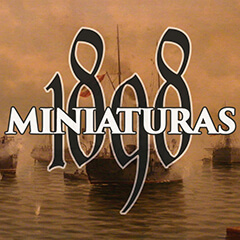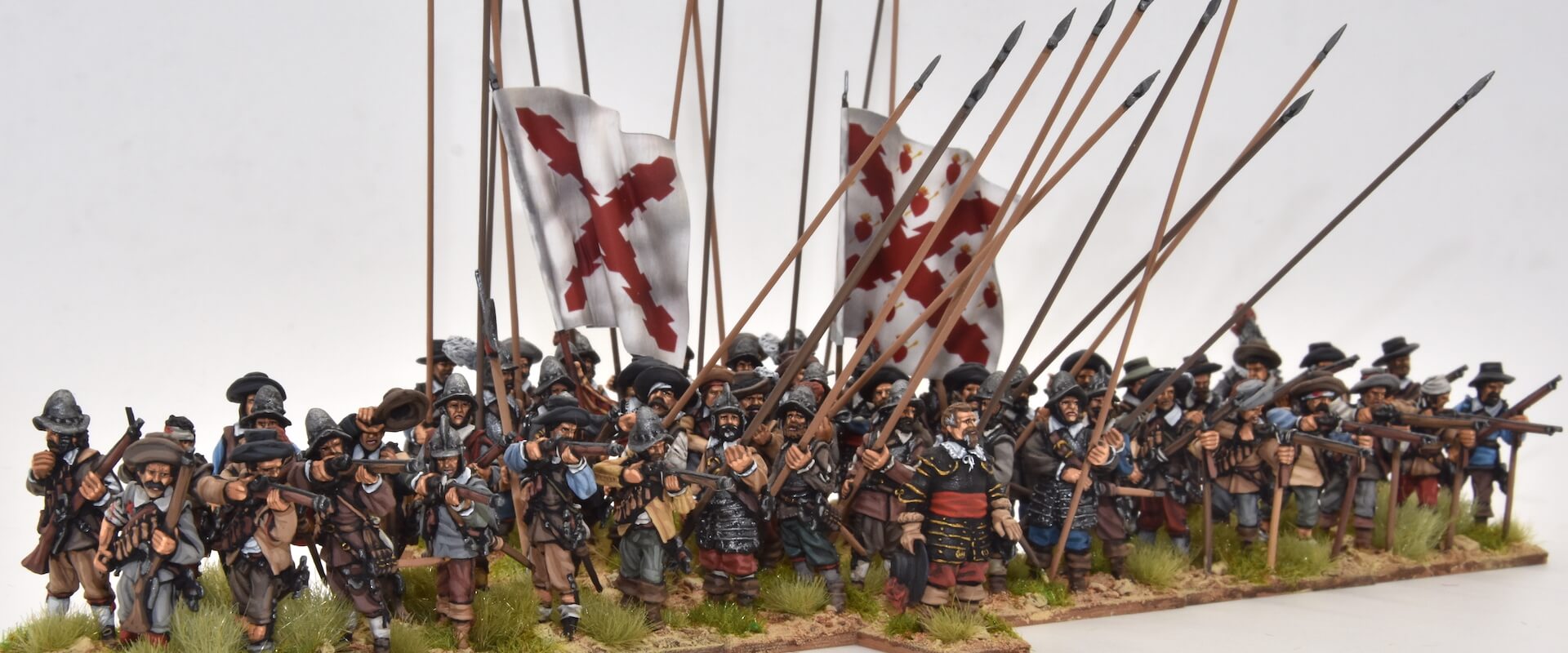Tercios clothing. Spanish military fashion in the 17th century (1600-1650)
Àlex Claramunt Soto
Desperta Ferro Ediciones

The clothing and defensive equipment of the soldiers of the Hispanic Monarchy, the famous tercios, underwent considerable evolution throughout the 17th century. This was influenced by both civilian fashion and its changing trends –for there are no uniforms as such–, with a strong French influence in the second half of the century, and the military needs of wars that were more lasting and massive than in the previous century.
The logistics of clothing
Before getting into matter we must take into account some preliminary considerations regarding the dress of the soldiers. First, despite the fact that no actual regulated uniforms were introduced until the Franco-Dutch War (1672-1678), the provision of clothing to soldiers in need of it –withdrawn from their pay, however– was always part of the logistics of the armies. These garments were made by civilian tailors from the province where the army operated, who manufactured them in large quantities. Thus, for example, in 1631 the Army of Flanders accountant paid 1,640 escudos to the tailor Gaspar Vandenleenput in payment of a thousand “munition clothes” –generic name of the complete military outfit–, 2,853 escudos to the Barthélemy Guisset hosiery for 2,500 pairs of stockings and shirts, and 786 escudos to Jan van Este and Co. for an undetermined number of pairs of shoes.
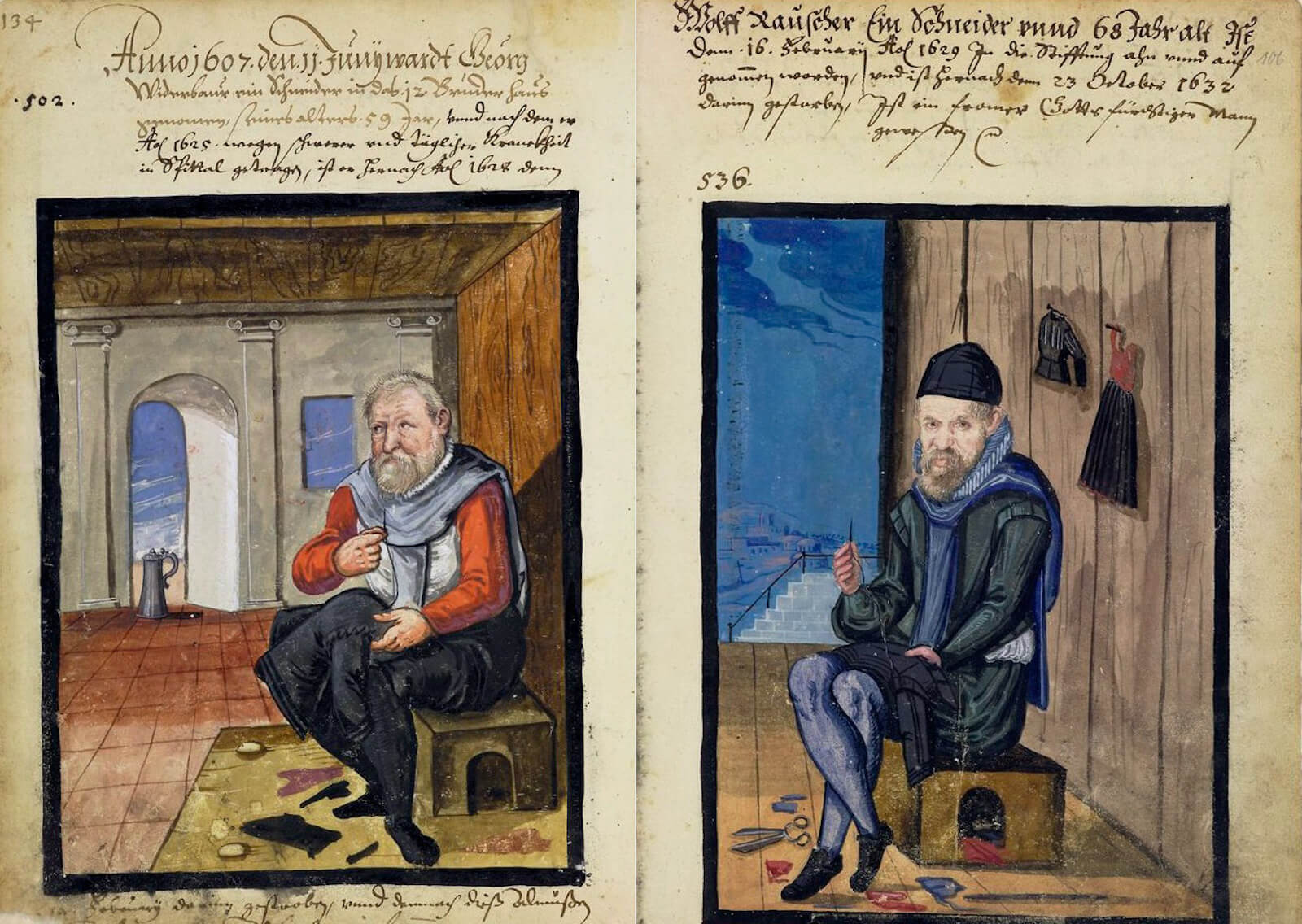
Drawings of tailors Georg Widerbaur and Wolff Rauscher (1607 and 1629) in the anonymous Hausbuch der Mendelschen Zwölfbrüderstiftung (“Book of the Mendelian Brotherhood House”), Stadtbibliothek Nürnberg.
The munition clothes were the quintessential garment of the newcomers, since, normally, they arrived at their destinations covered in rags due to the inclemency of the trip, which used to run through the rough Savoy and the Alpine gorges, following the “Spanish Road”, or aboard ships where hundreds of men were crowded in little space and in deplorable hygiene conditions. The soldier Domingo de Toral y Valdés, who traveled by sea to the Netherlands from Lisbon after enrolling in the Tercio de Cosme de Médici in Alcalá de Henares, explains it in his autobiography:
“We landed in Dunkirk in the month of November, year of 1615, so stripped that the most well-dressed were without shoes, stockings, or hat, and the common was nude, in such a way that the parts that honesty compels more to hide were more patent in sight; and because some covered them with their hands, they called them Adanes. When the Archduke Albert knew of such misery, he then remedied it by dressing everyone, from shoes to hats, and distributed them throughout Flanders in the garrisons and Tercios”.
Newly arrived recruits not only often require clothing, but also armor. This is indicated by Ensign Lorendo de Cevallos y Arce on the occasion of the landing in Dunkirk, in 1637, of the Tercio de José de Saavedra, from La Coruña: “4,200 men were found in the 24 companies, without officers; and the said accountant gave them some munition clothes and corselets, which they did not bring.”
Clothes and mentality
The clothing was an important element in the idiosyncrasy of the soldier, and it seems that, as soon as they saved enough money, they got rid of the boring munition clothes to obtain colorful clothing according to their condition. This is explained by the pícaro (rogue) soldier Estebanillo González in his alleged novelized autobiography:
“We arrived in Alexandria de la Palla, where, seeing us defeated (and not from battles or encounters), they gave us munition clothes, which in Latin are called mortuary dresses and in Spanish mortajas […]; for not appearing to be inexperienced being an old soldier and having done particular services (which if necessary will give me certifications, for being merchandise that has never been denied to any one), I pretended to be sick and I went to a hospital using the ruse of the tooth of garlic”.
Soldiers liked to dress ostentatiously, to such an extent that an anonymous document from 1610, entitled Las órdenes que paresce que se podrian dar para restaurar la reputacion y disciplina que solia haber en la infantería española (“The Apparent Orders That Could Be Given to Restore the Reputation and Discipline that Used to Be in the Spanish Infantry”), advises “to become preeminent about the quality of the weapons and clothing to be used in the said infantry, since it is known that of the surplus and excess that there is particularly in this, very many damages and inconveniences occur in it because they want to take advantage of the others, in the habit and costumes, more than in the service and works”. The paper includes a revealing reply: “never among the Spanish infantry has there been a pragmatic for clothing or weaponry, because it would take away the courage and spirit that soldiers [“gente de guerra”] need to have”. Mateo Alemán expresses a very similar reasoning in the picaresque novel Guzmán de Alfarache (1599), in which a soldier states:
“Your mercy wants to see what our bad luck comes to, that, being the finery, the feathers, the colors, that encourages and strengthens a soldier, so that with furious spirit he undertakes any difficulties and courageous undertakings, in seeing us with them we are outraged in Spain, and it seems to them that we must walk as solicitors, or become capigorristas [idler] students, in mourning and with gualdrapas, wrapped in black rags”.
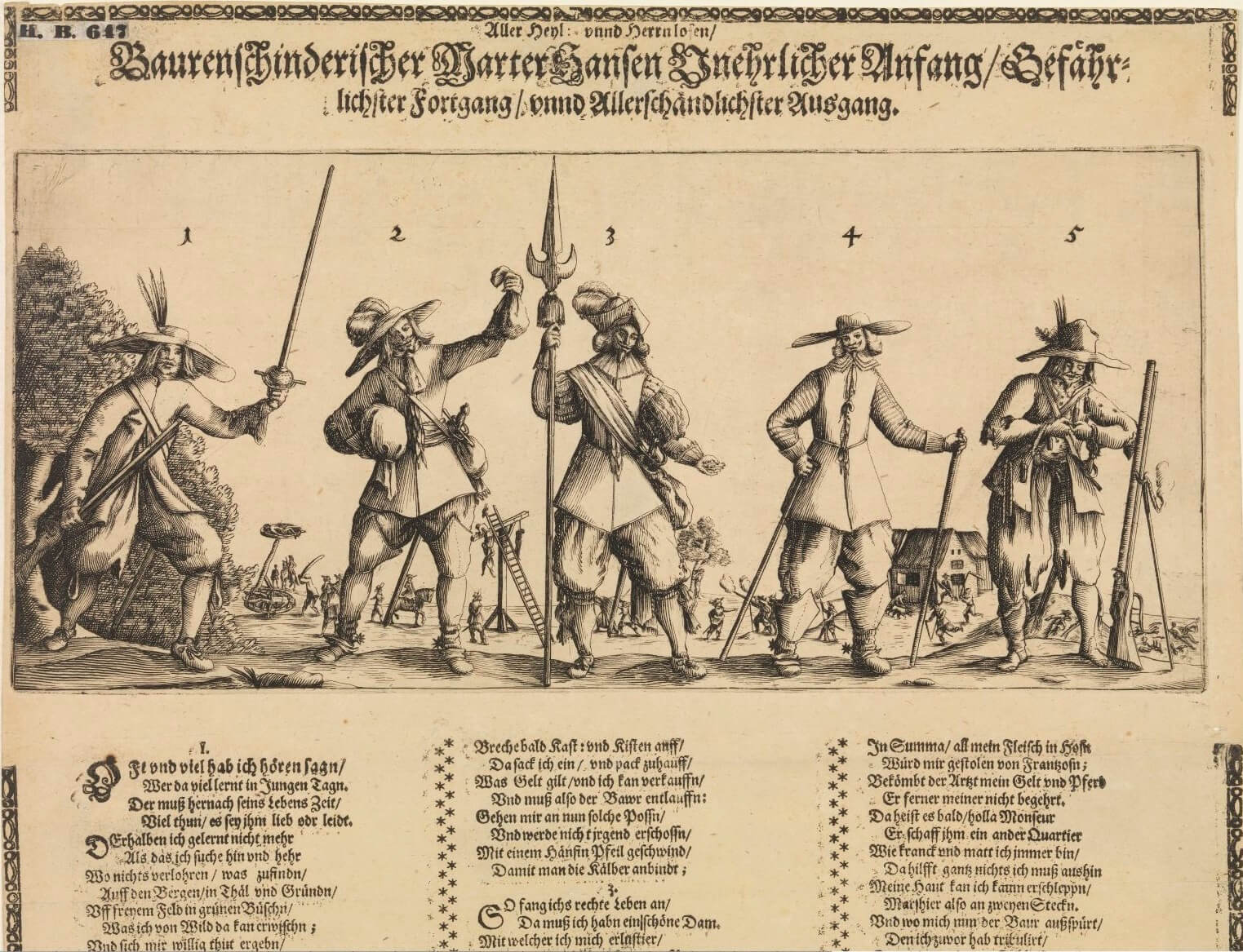
Baurenschinderischer Warter Hansen Unehrlicher Anfang Gefaehrlichster Fortgang und allerschaendlichster Ausgang (1622), anonymous engraving, Germanisches Nationalmuseum, Nuremberg.
This view can be extended to soldiers of all European nations, and is ironically reflected in an engraving published in Strasbourg in 1622 and titled The Dishonest Beginning, the Dangerous Progression, and the Shameful End of Construction Worker Hansen, showing how a soldier’s clothing becomes more ostentatious as he kneads loot, but only to end up irretrievably reduced to rags by the harshness of the campaigns.
The first third of the century
In the first two decades of the century, clothing and equipment hardly deviated from the fashion of the late sixteenth century. In the upper part of the body, the soldiers wore a shirt, and on this, a doublet that they in turn covered with a long, waist-length hide coat (coleto), sleeveless, or with “ropillas” that could or could not have sleeves –often hanging, with a more decorative than practical function. The lower part of the body was covered with breeches that went up to the knee and could be Greguesque, of a considerable volume, or more stylized, always accompanied by stockings. The footwear par excellence were leather shoes with a very light heel. A long sock was also popularized that was dressed over the stockings and bent before the knee at a variable height.

A musketeer and a pikeman in separate plates from the Wapenhandelingen (1608) by Jacob de Gheyn II (1565-1629), Rijksmuseum, Amsterdam.
The arquebusiers and musketeers wore no armor other than the coleto and, at most, a gorget to protect the neck. They were covered with wide-brimmed felt hats often decorated with feathers. The pikemen, on the other hand, still conserved the essential component of the infant “half armor” typical of the second half of the 16th century, known as the coselete. It is the cuirass, formed by the breastplate and the backplate, two different pieces assembled by means of straps with buckles. In the iconographic sources we find a few soldiers protected with rerebraces (pieces that covered the shoulders), while the vambraces and mittens (which protected the forearms and hands) had already fallen into disuse. Yes, there were still frequent the tassels, attached to the breastplate by straps, to cover the waist and upper thigh.
The most common helmets at this time were the capacete and the morion. These did not have ridges or other decorative elements, although they did, very often, have padded chins that offered some protection to the cheeks and chin. The width and sag of the wing of the moriones, as well as the height of the moriones and the capacetes could be variable, with a clear tendency towards a flatter and less pointed helmet than the moriones of the 16th century.
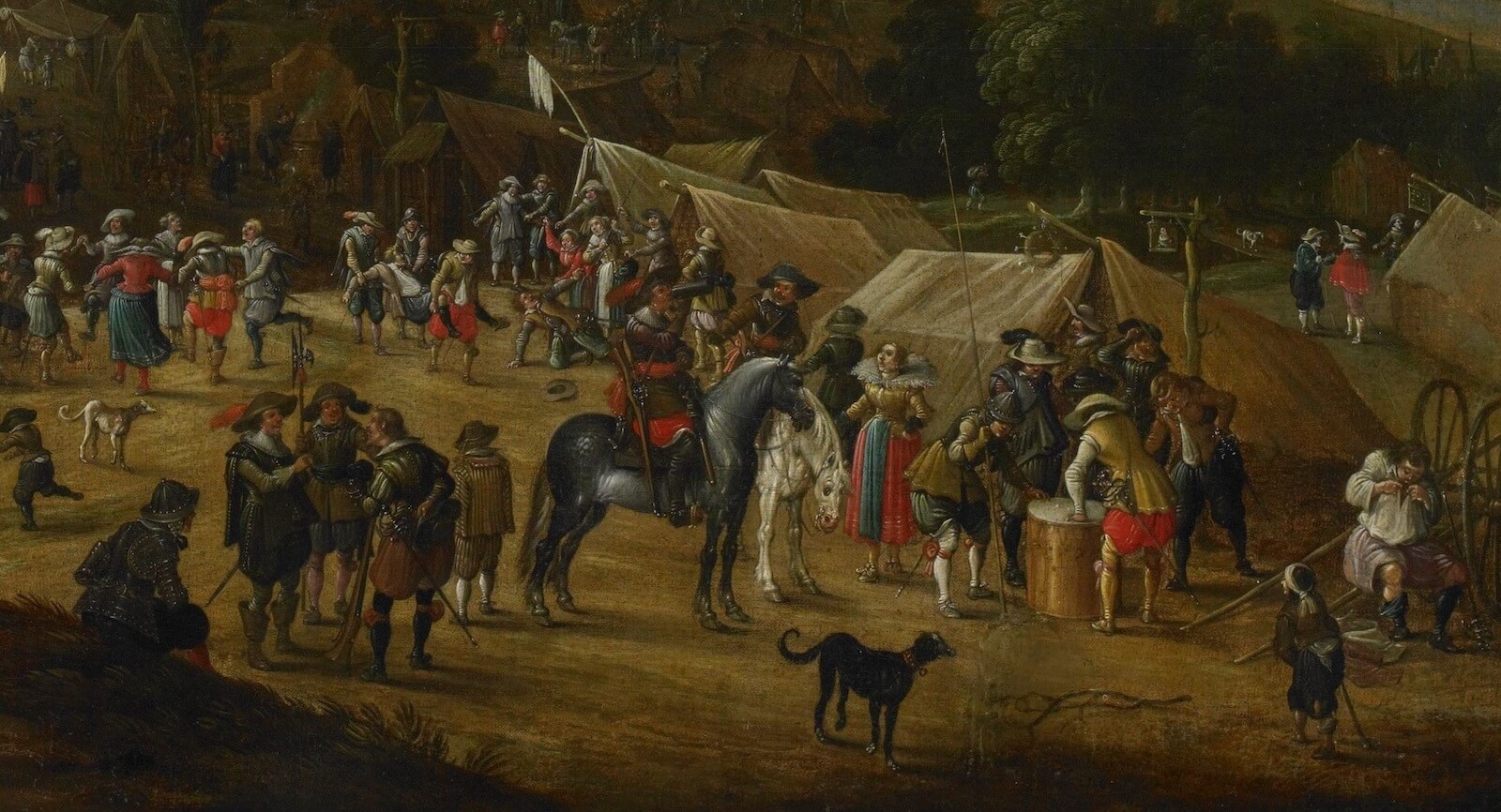
Detail of Prince Frederick Henry of Orange in the Siege of Bolduque (1631), oil on canvas by Pauwels van Hillegaert (1596-1640), Rijksmuseum, Amsterdam.
The uses so far described were largely indebted to the Spanish-Dutch military school, from where they spread to the rest of Europe from 1570. We find graphic examples of high quality and proven reliability in the Wapenhandelingen van Roers, Musquetten ende Spiesen (“Exercise of the arquebusiers, muskets and pikes”), a 1608 manual by Jacob de Gheyn II, as well as in the paintings by Sebastian Vrancx, Joost Cornelisz Droochsloot, Pauwels van Hillegaert, Jan Martszen de Jonge and Palamedes Palamedesz, whose naturalistic approach contrasts with the archaic and courteous armor and clothing of the canvases in the Salón de Reinos of the Palacio del Buen Retiro, made by artists without direct contact with the military world.
The French influence
Beginning in the 1630s, transformations took place thanks to the increasing influence of French fashion and the tactical transformations unleashed by Gustav II Adolphe of Sweden. The first assumption led to the definitive disappearance of the greguescos, who in the 1620s began to give way to narrower pants, fitted to the thigh. Also, shoes and boots –these, until then reserved for chivalry– began to be styled with higher heels. These boots had a very wide shaft and could have butterfly-shaped decorations on the instep. Although they were never the main footwear of infantrymen, we often see them in the works of Pieter Snayers, a Flemish painter of battles in the service of Cardinal Infante Fernando and Marshal Octavio Piccolomini.

A French musketeer and pikeman in the treatise Le mareschal de bataille, contenant le maniment des armes (1647) by the lord of Lostelneau; engravings of Petrus Rucholle (1618-1647), Rijksmuseum, Amsterdam.
In the 1630s and 1640s, the number of pikemen was gradually reduced to one-third or even less by each company, and the vambraces disappeared altogether. The lobster, a helmet of Eastern Europe origin used by the Holy Roman Empire cavalry, made an appearance, in turn, to a small extent among the foot soldiers. In parallel, many men began to discard their breastplates and helmets, which is why, around 1650, we found that many of the pikemen lacked metallic protections despite what the ordinances dictated. The main reasons for this abandonment were the increasing effectiveness of firearms, which increased in caliber and power, and the search for greater comfort by the soldier, who had to be more versatile and move faster in wars now dominated by the cavalry.
In parallel, a new garment appeared, the casaca (casaque), with French roots and that could be long up to something beyond the waist –as was usual in the middle of the century– or up to the knees, in which case it was called chamberga. This garment formed the basis on which the first uniforms were implanted and was extended to dragons and cavalry from the 1660s onwards in all European armies.

Detail of The capture of Saint-Venant (ca. 1649-1654), oil on canvas by Pieter Snayers (1592-1667), Museo del Prado, Madrid.
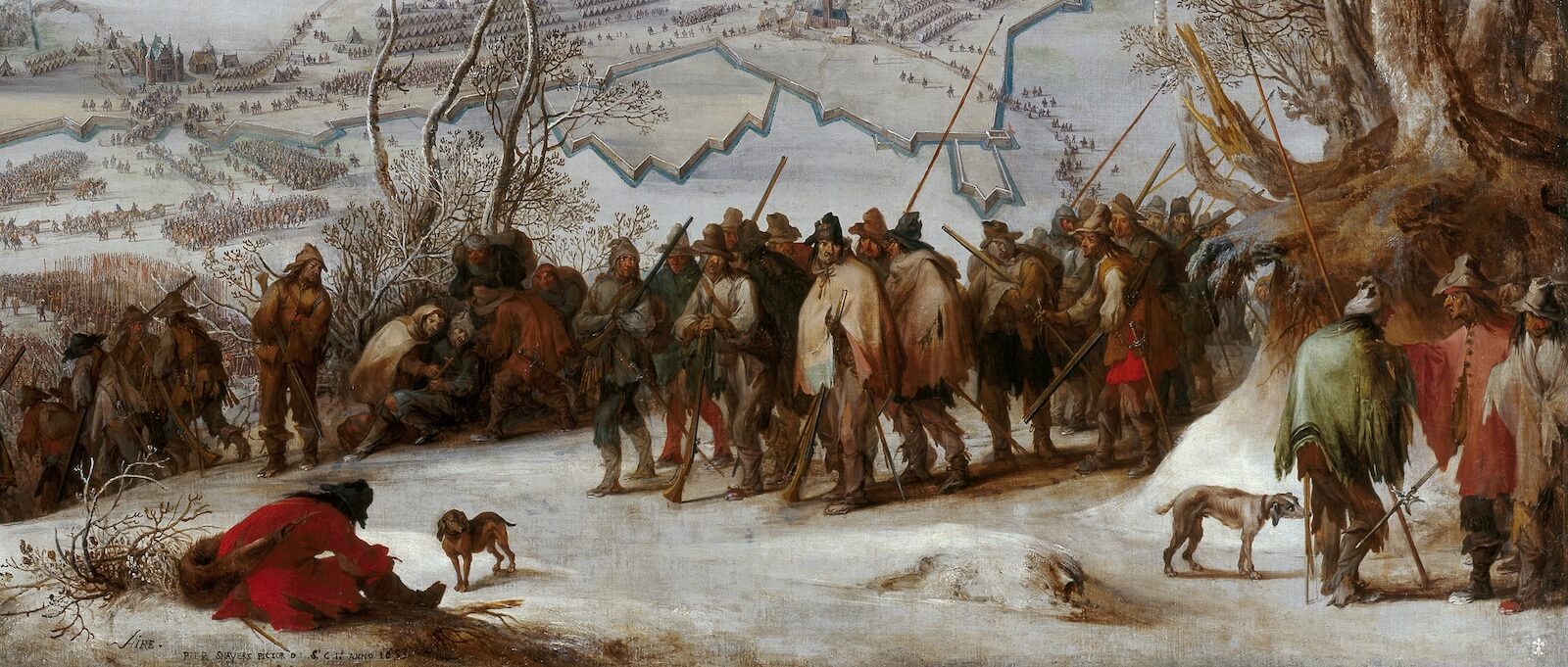
Detail of The siege of Aire-sur-la-Lys (1653), oil on canvas by Pieter Snayers (1592-1667), Museo del Prado, Madrid.
Aside from Pieter Snayers’s paintings, which are the best source for knowing soldiers’ appearance from 1640 to 1660, the works of other Flemish painters, such as Pieter Meulener and Cornelis de Wael, also provide excellent examples of fashion and equipment of the period. The same can be said of the paintings of the genre of the guard rooms captured by Flemish and Dutch artists such as David Teniers the Younger, Cornelis Mahu, Jan Baptist Tijssens the Younger, Gerard ter Borch, Gillis van Tilborgh, Anthonie Palamedesz and François Duchatel, among others. For the 1660s and beyond, we had the meticulous paintings of Adam Frans van der Maulen –Snayers’ most outstanding disciple, in the service of Louis XIV–, Lambert de Hondt the Younger and Pieter Wouwerman.
Hair fashion
In the initial decades of the century, the closed beards typical of the second half of the 16th century were still abundant and the hair was worn quite short, although not shaven. However, it was not long before the fashion of the moustache and the chin puff prevailed, and the hair grew progressively. From 1630 onwards, long manes abounded, at the same time that some soldiers, under French influence, changed the moustache with chin puff for a thin and curled moustache without complement in the chin, a fashion that would become popular throughout the 1650s and 1660. Wigs, also of French origin, were not common in the armies of the Hispanic Monarchy until the last two decades of the century, and always restricted to official status.
Officers
The clothing of the commanders, like that of the troops, was influenced by civilian clothing. Far from the restrained fashion that prevailed in the Madrid court, the officers of the armies of the monarchy favored the colorful garments of brocade fabric with passementerie. The neck and cuffs of lechuguilla, popular at the beginning of the century, fell into disuse in favor of the golilla and, above all, the Walloon collar. Alonso de Contreras describes his clothing as a cavalry captain in the early 1630s in detail: “Chamois breeches full of golden passementerie, the same for the sleeves and the coleto, a forest of blue and green and with feathers on top of the helmet, and a red band covered with gold, which, faithfully, could serve as a blanket on a bed”.
Another interesting example is found in the José de Pellicer’s Avisos (“Notices”), when in 1644 Felipe IV dressed as a soldier on the occasion of the visit to the headquarters and parade ground of the Army of Catalonia, in Fraga. The gold and silver threads were habitual: “He honored [his men] with dressing as a soldier, fair breeches, silver embroidery, sleeves of the same, plain buckskin coleto, red band, silver embroidery, red hooded cloak, silver cords, silver dress sword and spurs, fallen Valona (Walloon collar) and black hat with crimson feathers”.
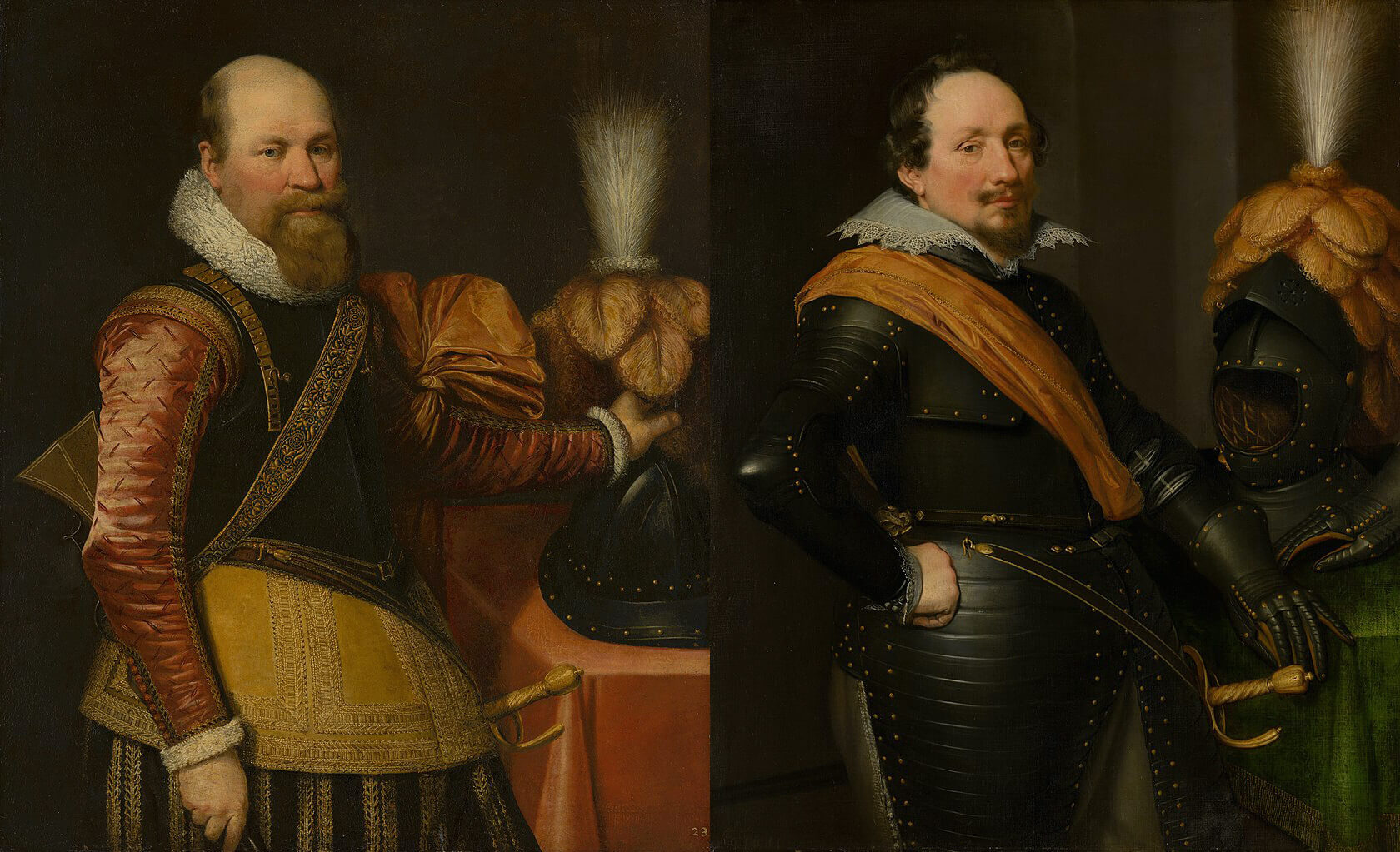
Army officers of the United Provinces portrayed around 1611 by Jan van Ravensteyn (1572-1657), Mauritshuis, The Hague.
In the first third of the century, officers used to protect themselves with three-quarter armor, that is, the full knight’s harness except for the knee-down pieces –knee poleyn, greaves, and sabaton– where they wore breeches and riding boots. The visor headpiece was popular until the mid 1630s along with closed burgundy, which offered complete head protection. From the previous years, lobster helmet, imported from Hungary, became popular. It is an open helmet, but with good protection thanks to its neck cover, which gave it its name, wide cheeks and a nasal protector that could cover much of the face. The morion and the capacete continued enjoying popularity among the infantry commanders, while the burgonet helmet disappeared during the 1620s.
In the series of portraits of field masters commissioned by the Marquis of Leganés, governor of Milanesado and captain general of the Lombardy Army, in the late 1630s we observe that all wear robes and breeches made of gold and silver threads, with Walloon collar and golillas, and who wear riding boots with butterfly-shaped decorations. Some protect themselves with gorget, while others choose a buff on which they carry a breastplate –breast and backplate. Neither wears a helmet, but we do observe some lobster among the accessories, from which we can deduce that the most complete armor, as well as heavier helmets and closed burgonets, more bulky, were relegated, from the end of the 1630s, to mere aesthetic ornaments for portraits. It would come to confirm the appearance of the officiality in the pictures of Pieter Snayers.
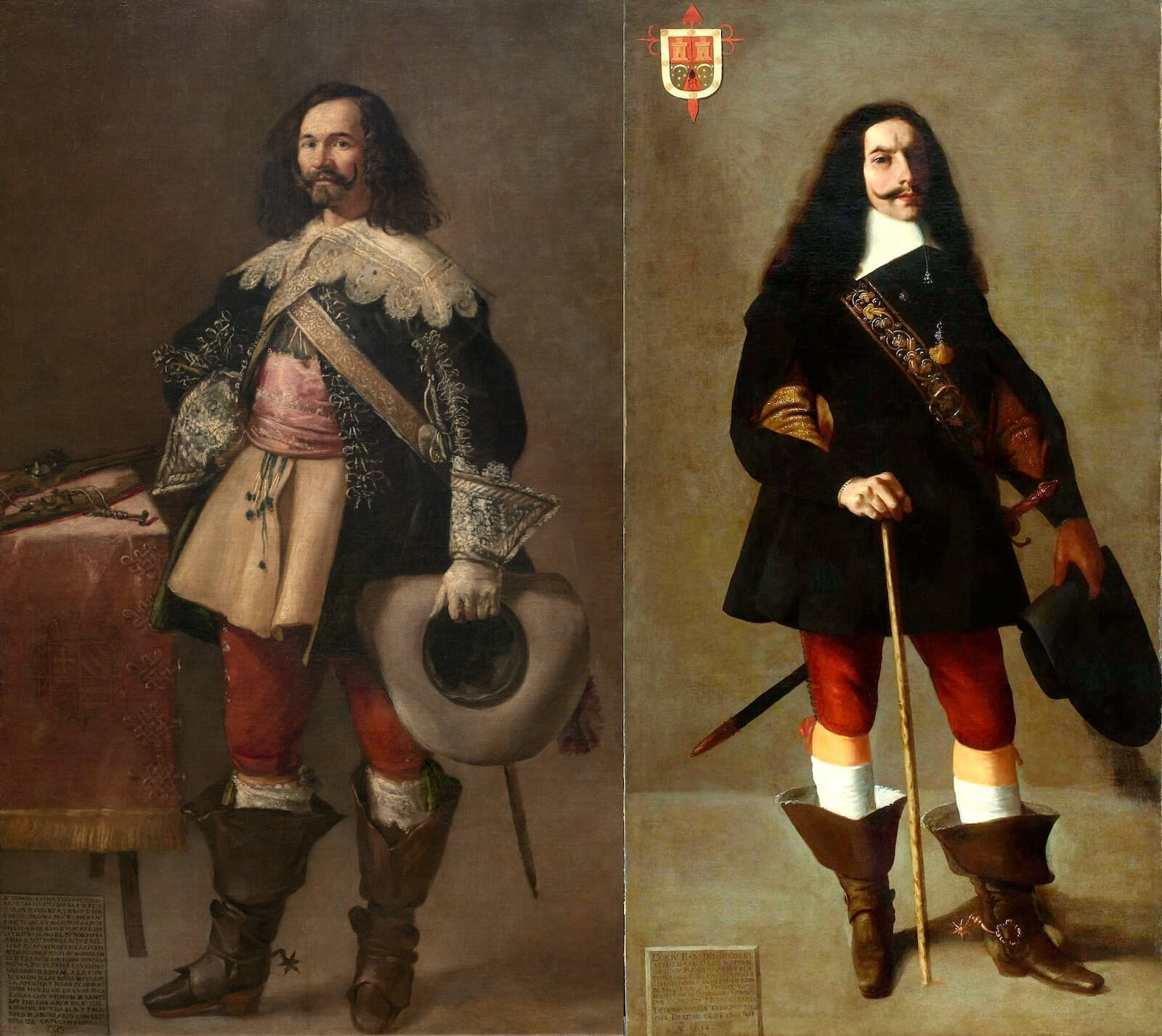
The Field Master Tiburcio de Redín (1635), oil on canvas by Fray Juan Andrés Rizi (1600-1681), Museo del Prado, Madrid; and The Sergeant Major Juan Bazo de Moreda (1655), oil on canvas by Francisco de Zurbarán (1598-1664), Detroit Institute of Arts.
At the same time, the frenchification became evident from that time on with the appearance of the casaque and, from the 1650s, on more voluminous doublets and robes adorned with colorful ribbons, bows and flounces. In the last twenty years, wigs, long and with curls, would be present, and golilla collars would give way to ties.
Further readings
Bru, J. y Claramunt, A. (2020): Los tercios. Madrid: Desperta Ferro Ediciones.
Bueno, J. M. (1978): Soldados de España. El uniforme militar español desde los Reyes Católicos hasta Juan Carlos I. Málaga: Summa.
Manzano Lahoz, A. (1993), “La uniformidad y las banderas”, en VV.AA.: Historia de la Infantería Española. La infantería en torno al Siglo de Oro. Madrid: Ediciones Ejército, pp. 369‑416.
Mollo, J. (1972): Military Fashion: A Comparative History of the Uniforms of the Great Armies from the 17th Century to the First World War. New York: Putnam.
Rodríguez Hernández, A. J. (2017): “La evolución del vestuario militar y la aparición de los primeros uniformes en el ejército de la Monarquía Hispánica, 1660‑1680”. Obradoiro de Historia Moderna, 26, pp. 179-206.


